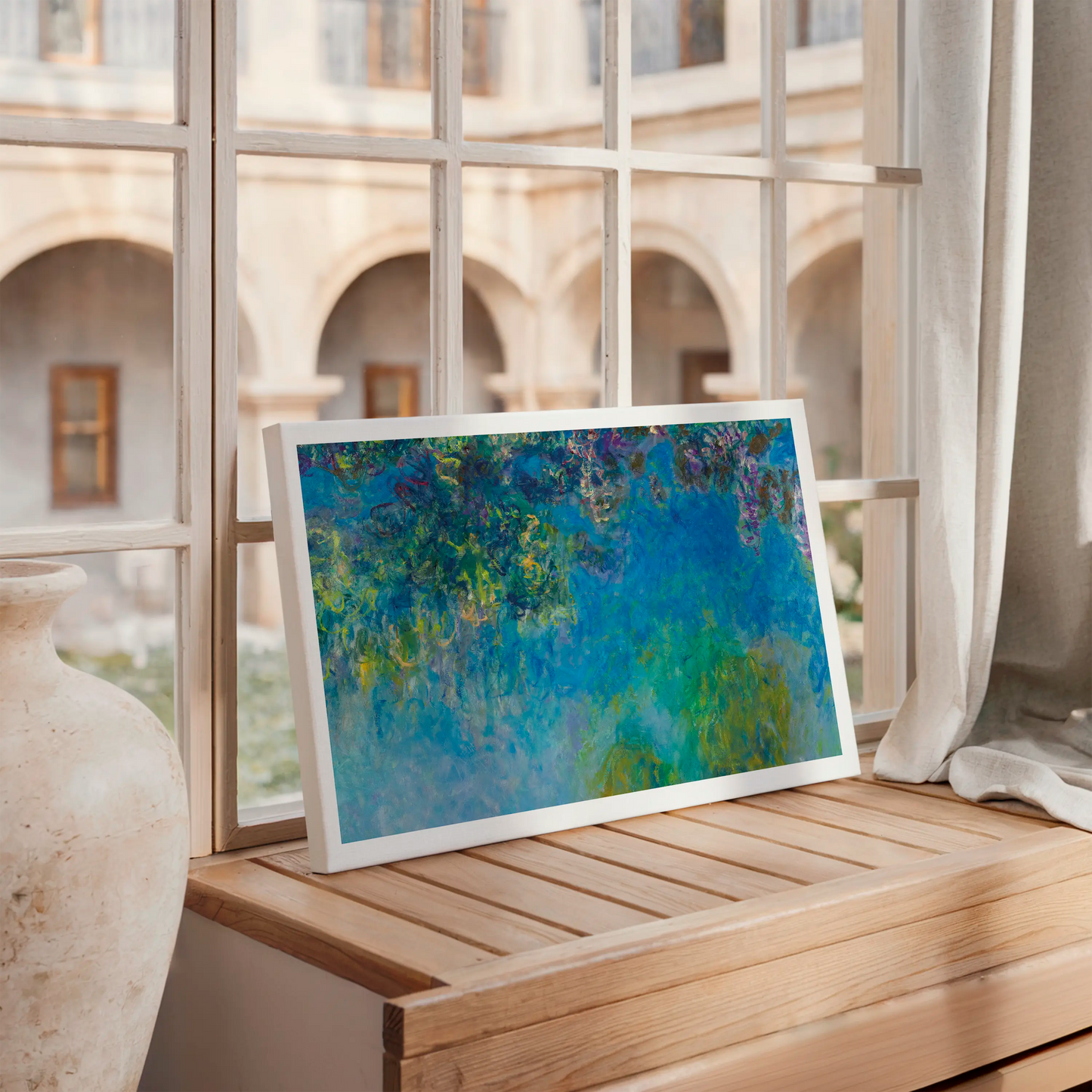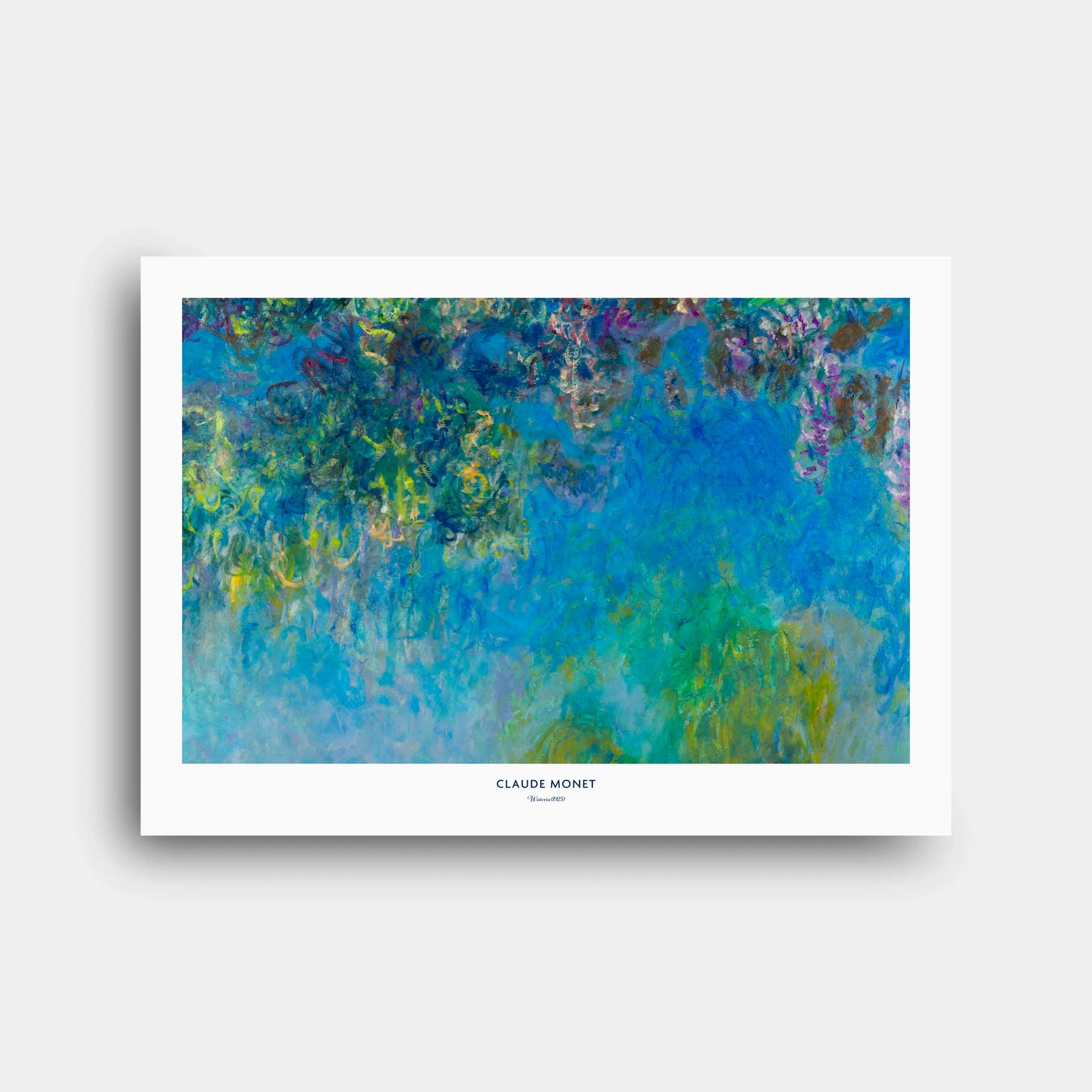Claude Monet - Wisteria (1925) - Canvas Print N168
Claude Monet - Wisteria (1925) - Canvas Print N168
Couldn't load pickup availability
Share
Paper Poster | Canvas Print | Digital File
1. Historical and Artistic Context
Claude Monet painted Wisteria around 1925, during the final years of his life in Giverny. By then, Monet was in his eighties and deeply immersed in his grand project known as the “Grandes Décorations.” These monumental compositions of water lilies, reflections, and floral garlands were conceived as a gift to France after World War I, symbolizing peace and renewal. While his water lily panels were installed in the Musée de l’Orangerie in Paris, the wisteria paintings remained in his studio, largely unseen and underappreciated until much later. This work represents Monet’s continuous fascination with his gardens, particularly the Japanese bridge covered with cascading wisteria. It was created at a time when avant-garde movements like Cubism and Surrealism dominated the art scene, yet Monet persisted in his own exploration of light, color, and nature’s abstraction.
2. Technical and Stylistic Analysis
The painting demonstrates Monet’s mature, almost abstract style. The canvas is dominated by luminous blues, greens, and violets, interwoven with looping brushstrokes that suggest hanging garlands of blossoms. The upper section appears dense with overlapping colors, while the lower part fades into a softer, more atmospheric field. Monet’s use of layering creates depth without linear perspective, immersing the viewer in an endless tapestry of color. His brushwork is bold and free, with impasto accents giving physical presence to the paint. Rather than depicting individual flowers, Monet dissolves form into light and motion, creating an immersive vision that feels both fleeting and eternal. This stylistic approach bridges Impressionism with modern abstraction, making the painting resonate with 20th-century abstract art.
3. Symbolism and Interpretation
While Monet did not intend overt symbolism, the painting carries suggestive meanings. Wisteria is often associated with grace, longevity, and spiritual reflection, qualities fitting for Monet’s late years. The draping forms may symbolize a natural garland, crowning his water lily compositions with a celebratory flourish. At the same time, the almost dreamlike abstraction can be read as a meditation on memory and vision, particularly poignant given Monet’s struggle with cataracts. The viewer might feel as if standing beneath a canopy of blossoms, experiencing both serenity and dissolution. This merging of vision and sensation reflects Monet’s lifelong quest to capture the intangible essence of light and atmosphere.
4. Technique and Materials
Wisteria was executed in oil on canvas, with a surface that reveals multiple layers of paint. Monet applied both translucent washes and thick impasto, creating dynamic contrasts between blurred fields and crisp strokes. Conservation studies have uncovered a hidden water lily painting beneath the visible wisteria, suggesting Monet repurposed the canvas as part of his experimentation. Additionally, shards of glass embedded in the fibers tell of damage sustained when Monet’s studio roof collapsed during World War II bombings. The pigments used include modern 19th-century colors such as cobalt blue, viridian, and cadmium, which contributed to the vibrancy of his late works. The painting is framed in a semi-circular gilt frame, echoing the arching shapes of the flowers.
5. Cultural Impact
Although overshadowed by the water lilies, Wisteria has influenced later art, particularly Abstract Expressionism. Painters like Joan Mitchell and Mark Rothko admired Monet’s late canvases for their all-over fields of color and immersive scale. The rediscovery of the hidden lilies beneath the painting in 2019 attracted media attention, renewing public interest in Monet’s experiments. Exhibitions pairing Monet with modern abstract artists highlight the continuity between Impressionism and postwar abstraction. Beyond the art world, Monet’s gardens and floral imagery continue to inspire designers, educators, and immersive digital exhibitions, bringing his vision to contemporary audiences.
6. Critical Reception and Scholarly Interpretations
At the time of Monet’s death, critics often misunderstood these late works, attributing their blurred forms to failing eyesight. The wisteria paintings in particular were largely forgotten, as the Orangerie installation focused on the water lilies. However, by the mid-20th century, scholars and critics began to reevaluate Monet’s late period. André Masson famously dubbed the Orangerie the “Sistine Chapel of Impressionism,” and others saw in Monet’s all-over canvases a precursor to abstraction. Today, Wisteria is appreciated as a vital link in Monet’s oeuvre, demonstrating his willingness to push Impressionism toward new, visionary frontiers. Scholars now emphasize its expressive force and its role in the broader “Grandes Décorations.”
7. Museum, Provenance and Exhibition History
The painting is housed in the Kunstmuseum Den Haag (formerly Gemeentemuseum) in the Netherlands, acquired in 1961 from Swiss dealer Ernst Beyeler. It is one of only three Monets in the collection and has been on nearly continuous display since its acquisition. The work featured prominently in the 2019–2020 exhibition “Monet: The Garden Paintings,” where conservators revealed the hidden lilies beneath its surface. Although never included in the Orangerie installation, it is now recognized as part of the broader cycle of garden paintings. Its conservation history also highlights its survival through war damage and extensive restoration.
8. Interesting Facts
1. Painted in Monet’s eighties, making it one of his last major works.
2. Originally part of the “Grandes Décorations” plan as a crown above the lilies.
3. Hidden water lilies were discovered beneath the surface in 2019.
4. Glass shards in the canvas came from bomb damage during World War II.
5. Only about eight wisteria paintings by Monet are known to exist.
6. The Kunstmuseum Den Haag owns just three Monets, including this one.
7. The painting retains its unique semi-circular gilt frame echoing the subject.
8. It was overlooked for decades compared to the famous water lilies.
9. Conservation removed a heavy varnish that had dulled Monet’s colors.
10. Its abstract qualities inspired later modernists like Rothko and Mitchell.
9. Conclusion
Claude Monet’s Wisteria is a profound statement from the twilight of his career. Though once overshadowed, it is now seen as a bold experiment linking Impressionism with abstraction. Its vibrant palette, expressive brushwork, and immersive composition testify to Monet’s relentless pursuit of light and atmosphere. Bearing scars of history and layered with hidden imagery, the painting embodies both personal expression and cultural memory. Today it stands not only as a masterpiece of late Impressionism but also as a visionary bridge to modern art, ensuring Monet’s legacy endures as both innovator and poet of color.











